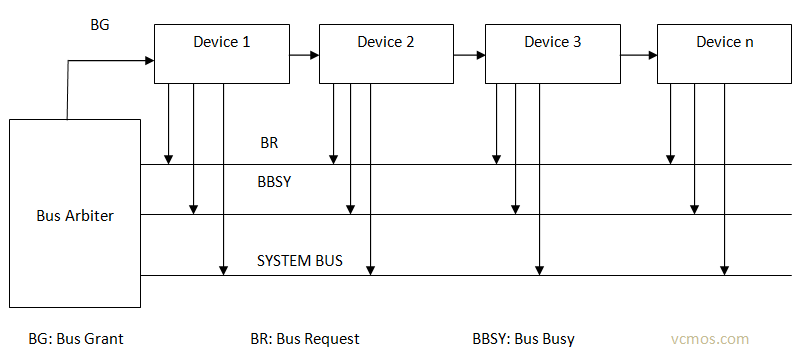Bus arbitration is the process of determining which component or device in a computer system gets access to a shared bus when multiple components want to use it simultaneously.
This is crucial to ensure that different parts of the computer can communicate with each other efficiently and avoid conflicts.
Here are the main types of bus arbitration:
1. Centralized Bus Arbitration:
- In this method, there is a single central controller that manages access to the bus.
Advantages: It’s straightforward and ensures a clear order of access.
Disadvantages: It can lead to delays if the central controller becomes a bottleneck.
2. Distributed Bus Arbitration:
- In distributed arbitration, each device on the bus independently requests access.
Advantages: More flexible and can handle varying traffic loads.
Disadvantages: May require more communication between devices.
3. Priority-Based Arbitration:
- Devices are assigned priorities, and the one with the highest priority gets access first.
Advantages: Ensures high-priority tasks are handled promptly.
Disadvantages: Low-priority tasks may experience delays.
4. Round-Robin Arbitration:
- Devices take turns accessing the bus in a fixed order, regardless of their priority.
Advantages: Fair distribution of bus access.
Disadvantages: High-priority devices might wait longer.
1.
Centralized Bus Arbitration Methodologies
Methods of Centralized Bus Arbitration:
- Daisy chaining
Daisy chaining is a bus arbitration method used to manage access to bus, in a sequential manner. In this method, devices are connected in a chain, and only one device at a time has control over the bus. When a device finishes using the bus, it passes control to the next device in the chain. Here’s how daisy chaining works:
- Device Chain: Devices that need access to the bus are connected in a linear chain, one after the other. The first device in the chain has the highest priority, and the last device has the lowest priority.
- Bus Request: When a device wants to use the bus, it sends a request signal to the next device in line. If the bus is currently free (no other device is using it), the requesting device gains immediate access.
- Bus Usage: The requesting device uses the bus for its operation and set BBSY line.
- Bus Release: After completing its operation, the device releases the bus. It then informs the next device in the chain that it’s done and that the next device can take control of the bus.

Advantages of Daisy Chaining:
- Fairness: Daisy chaining ensures that each device in the chain gets a turn to use the bus, promoting fairness in resource allocation.
- Simplicity: This method is relatively simple to implement and doesn’t require a centralized controller.
- Predictability: The order of access is well-defined, making it easier to predict when a device will have access to the bus.
Disadvantages of Daisy Chaining:
- Latency: Lower-priority devices in the chain may experience higher access latency, especially if higher-priority devices frequently request the bus.
- Inefficiency: If a high-priority device needs the bus frequently, it can lead to inefficiency for lower-priority devices, as they must wait their turn.
- Limited Scalability: Daisy chaining may not be suitable for systems with a large number of devices, as the chain can become lengthy, increasing access latency.
0 Comments